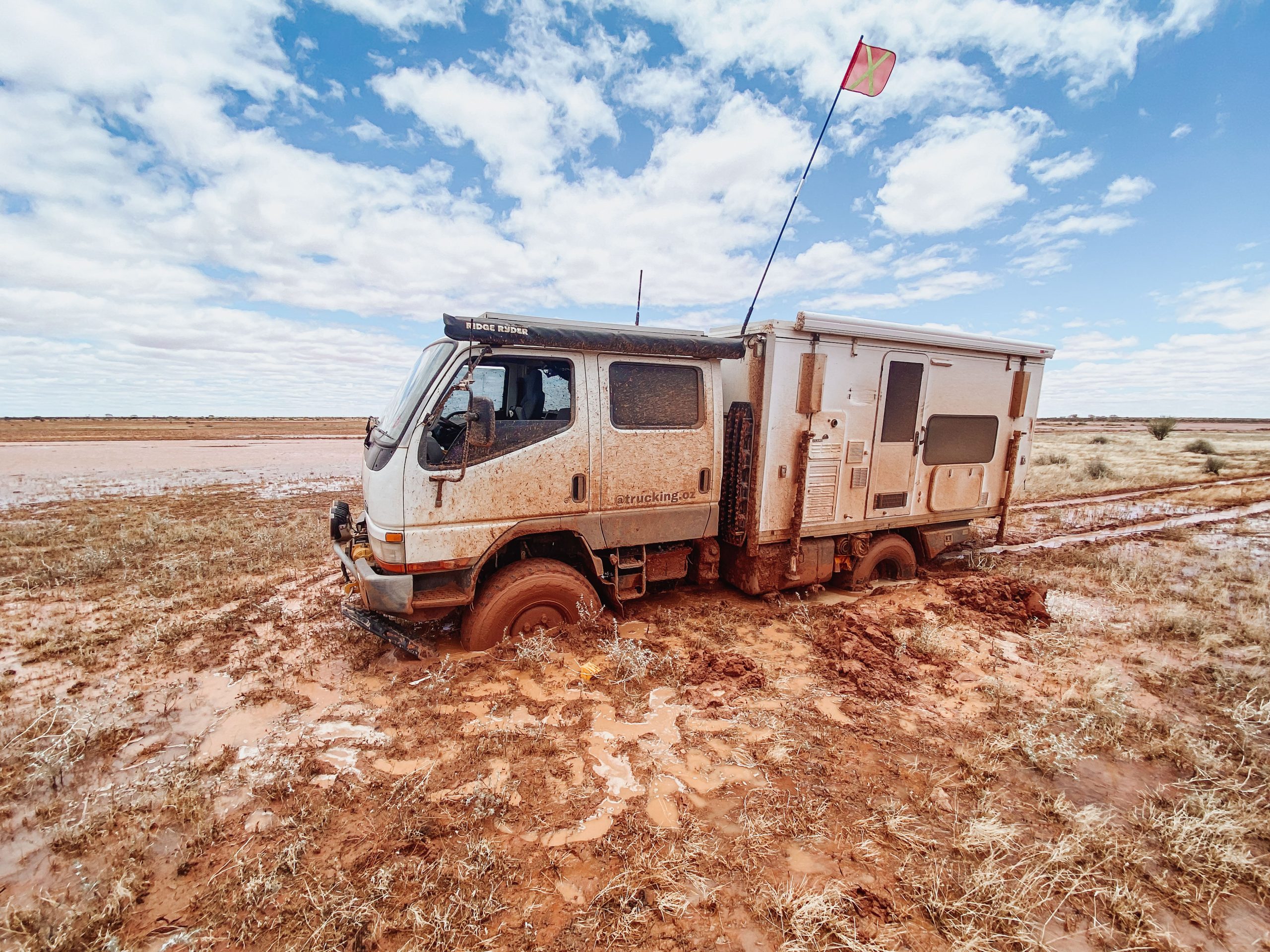This is a story of preparedness, teamwork, resilience, and love. It is an insight into the power of the press, the positives and negatives of the digital world, and an intimate, raw, and self-effacing account of an overlanding disaster.
In 2021, nearing the end of their 14-month Australian adventure, the Zavros family, also known as Trucking Oz, made international news when freak weather left them bogged in the notorious Simpson Desert. I had previously featured their expedition-ready Mitsubishi Canter 4×4 and was shocked when I recognized the rig from aerial footage on the news. Ori is one of the most experienced overlanders I have ever had the pleasure of speaking to, with over 15years of backcountry vehicle travel under his belt. He has built 17 dedicated expedition rigs from the ground up for off-grid travel and extreme off-roading and spends his free time exploring some of Australia’s most remote locations. I knew right away that something completely unforeseen must have occurred.
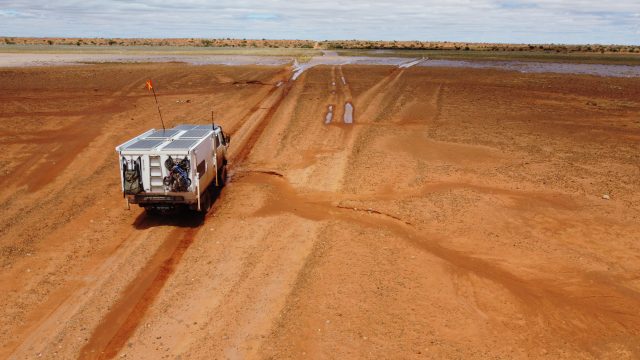
I reached out to Ori to let him know I was thinking of them, and that I was relieved to see emergency services were planning their rescue. The family’s situation was already international news, and that generated a lot of support, but inevitably sparked misinformed criticism. We’ve all seen sensationalized stories of unprepared travelers heading into the backcountry, getting into trouble, and putting unnecessary stress on emergency services. The Zavros’ story is a fascinating case study, because they did almost everything right, but were ultimately at the mercy of Mother Nature. It’s a reminder that even with the best intentions, research, and planning, we can all be caught out by the unforeseen. Ori is the first person to point out where they could have made better choices, but as we all know, hindsight is a wonderful thing. Sure, it’s easy to dissect every action from the couch, but the decisions they made as a family were carefully considered, objective, and ultimately ensured their safe rescue. The family asked me to share their story in the hope that the lessons learnt from the experience will be of value to the overlanding community.
The Simpson Desert crossing has always been on your bucket list. What makes this route so attractive?
A big part of the appeal is remoteness and exclusivity. You can’t tow a caravan, and even a trailer is frowned upon, so that limits a lot of people making the journey. I don’t know anyone from my family or friends that have attempted it, so that made the goal quite special. I watched people crossing the Simpson on old 4WD DVDs when I was 15 years old and it has been a dream of mine ever since.
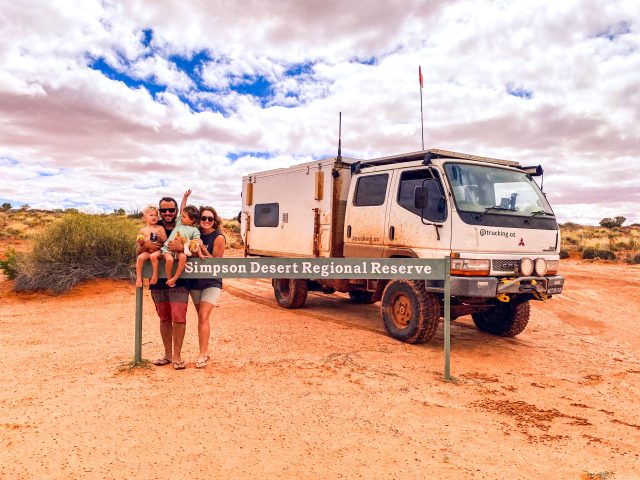
What recovery gear is the Mitsubishi equipped with for remote unsupported travel?
The truck has a 17,000-pound winch up front and an 11,000-pound winch fitted to the rear. We have a snatch block, tree trunk protectors, snatch straps, a winch extension, and chains, and we have rated recovery points all around the vehicle. In addition, we have a compressor, four MaxTrax, shovels, jacks, and a spare tire that can be utilized as a ground anchor.
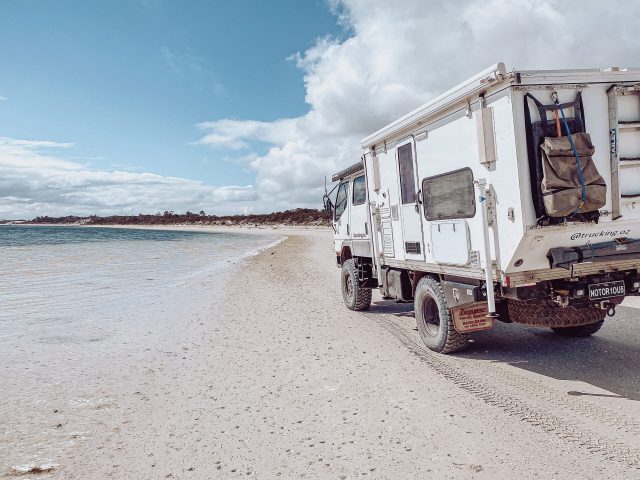
How did you prepare for the Simpson crossing?
First and foremost, we packed a PLB (personal locator beacon), which ended up being our only form of communication and ultimately saved us. We also carry a UHF radio, but that’s only good for about 8 kilometers of range. We actually purchased the PLB at the start of our trip because the Simpson crossing was one of the first objectives. However, we always check conditions in advance and had seen reports of flooding, so decided we’d tackle it on the return journey. Additionally, we have an extensive first aid kit to ensure we’re covered for as many scenarios as possible, and ahead of the Simpson, we filled our fridge with water exclusively. This meant our family had enough water [and food] to survive in the desert comfortably for two weeks [the crossing is between 550-715 kilometers and is expected to take four to five days].
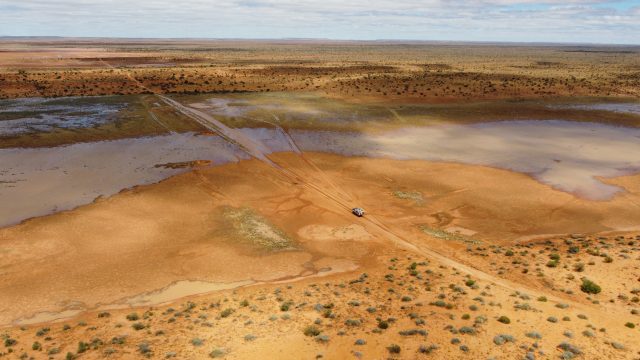
Did you have any particular concerns regarding the crossing prior to departure?
The truck is so capable and has proven itself time and time again, and perhaps that made us a little over-confident. I was concerned about the remoteness, especially the mud flats, and realized that if we broke down, we could be stuck out there for some time—but we were prepared for such an eventuality). At the end of the day with the best will in the world, you can’t plan for everything. We carry a huge set of tools and spare parts, but that doesn’t prevent some obscure five-cent component from leaving you stranded.
Can you share your thoughts on the crossing before things took a turn for the worst?
Up to the point of being stuck, it was incredible. I’d expected a harsh desert, but I was surprised by how much greenery there was. It’s a serious undertaking with a lot of driving and thousands of sand dunes along the road.
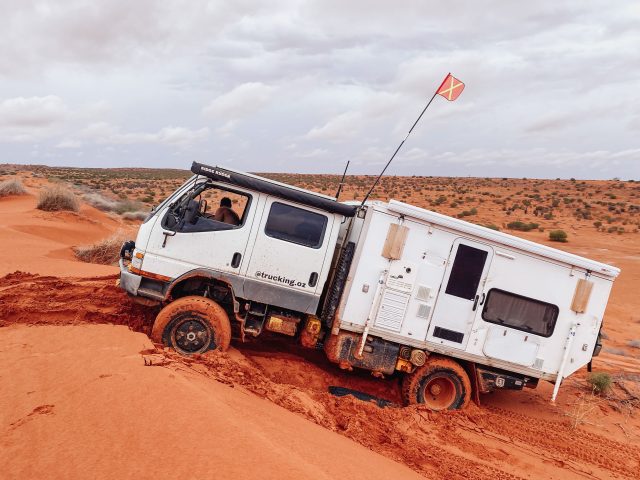
At what point did you have concerns?
As soon as we hit the mud flats, I got a pit in my stomach. I didn’t know how many of them we’d need to cross, and the first one was pretty waterlogged. I decided to send the drone up to get an aerial perspective and see whether there was a possibility to navigate around them, or at least bypass the worst sections. Unfortunately, the wind was really picking up, and I couldn’t risk flying too far ahead. That made me nervous because I’d hoped to have some idea of the conditions facing us. I was fully aware that if we got bogged down it would be hard to get free. What we didn’t know is that the roads out of the Simpson were already flooded, so even if we’d made it out of the mud flats, I don’t think we’d have been able to leave.
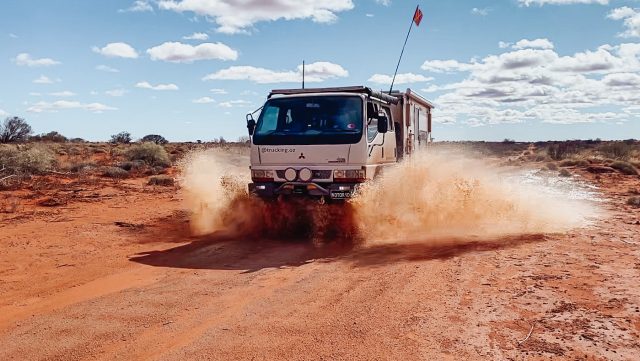
Once everything flooded, did your situation worsen suddenly or were you still able to make progress?
It was day three when the puddles started getting bigger, but I wasn’t especially worried as we were approaching the exit. In fact, we’d technically crossed the Simpson Desert boundary, so whether that means the crossing was successful or not, I’m not sure! I was feeling great, and even said to Lindsey, ‘We’ll be in Dalhousie in three to four hours.’ However, my confidence was short-lived as conditions quickly worsened, and I started to wonder whether we would get out at all.
Did you get bogged down progressively or was it a case of hitting a particularly bad spot?
We crossed three or four mudflats before we got stuck. The track was pretty flooded, but we stuck to it [as recommended]. The Mitsubishi was sliding all over the place on the first mud flat, so on the second one, we tried something different. We plotted a route to bypass it using the high ground, and that worked well. On the third mudflat, we clambered along the side of the track, which was slightly higher, and although it was sketchy, we passed comfortably. Then we arrived at the fourth, and the track was so deep underwater that we could hardly make it out. It was far too big to drive around, and I realized that attempting that could put us at greater risk. Our best option was to once again clamber along the side of the trail, and that worked fine initially. We were around 100 meters from the endpoint when it just became a complete bog, and we immediately sunk in. I used our recovery boards and was able to rock it forward a little, but the mud was so deep it was hopeless. I was in fourth gear low-range and it wasn’t moving an inch— we were just passengers at that point. I got out and the diffs were totally submerged.
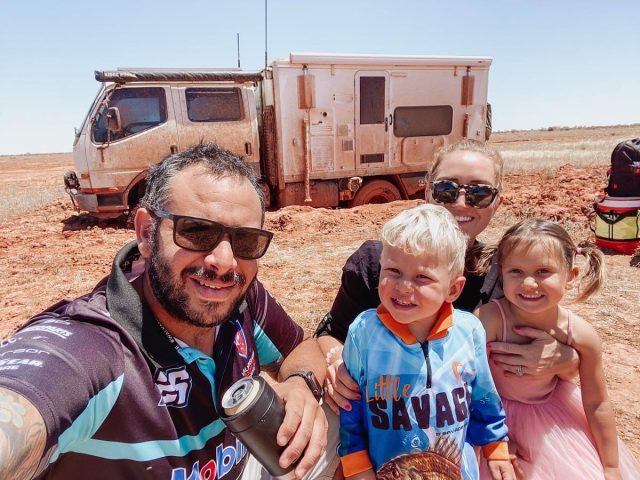
When did you decide it was time to call for help?
We tried to dig ourselves out for five hours on the first day of being stuck, but we made zero progress. That evening, we got cleaned up and before bed made the decision [to] try again in the morning, but if that didn’t show promise then we [would]set off the PLB. We didn’t know whether the desert was still open for crossings because when it rains hard, they close it off. I realized we were most likely totally alone. After another full day of digging, we decided it was time to activate the beacon. That was an emotional rollercoaster because I’d never had to call the emergency services, and I don’t take that decision lightly. We went into the camper with the kids, and four hours later we heard a plane fly overhead. It did about 10passes before dropping a care package to us with a siren attached so we could easily locate it. The moment I heard the plane I set our UHF radio to scan and eventually picked up the pilot. He explained there was a satellite phone, supplies, and water in the care package, and that the rescue was now being passed over to the South Australian police.
Was there a conversation about recovery or was the only option being airlifted?
They called us and explained that conditions were so bad that it could be weeks until a vehicle could reach us, and were even hesitant about sending a helicopter. They prepared us for potentially 14 days in the desert, but that wasn’t an issue as we’d packed the truck for such a scenario. We explained we had more than enough food and water for this duration, but they insisted on dropping extra provisions just to be safe. Three days later they supplied more food and water and maintained contact with us throughout. However, the weather then heated up with temperatures over 40°C, so they decided they wanted to get us out of the desert.
The satellite phone was a game changer, and the rescue team was amazing. They told us that we could use it to contact our loved ones and that it was important to take care of our mental health. The ability to call our family was massive, as they were extremely worried. When we set off the beacon, they contacted my family straight away. That meant that even before the emergency services knew whether we were okay, they received a message that the beacon had been activated. Just thinking about that makes me emotional.
The first thing I asked the search and rescue team was whether I could attempt to dig the vehicle out as the mud dried, but they said ‘no’ right away, because of the risk of someone getting injured. They also explained that currently, they knew our location. If we freed the truck and got stuck further down the line it would make locating us more difficult. They concluded that setting off the beacon early and staying with the vehicle was the right thing to do and that trying to get free could easily worsen the situation. It can take so little, like a cut getting infected, to make things much worse. There was a point early on when I contemplated taking our electric scooter to the nearest town, and Lindsey immediately said ‘No, You’re not going,’ and I knew that response was final. She was absolutely right; that’s how people die, especially in the desert.
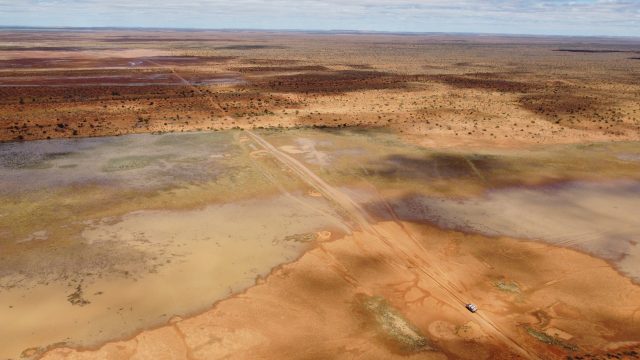
How did the rescue unfold?
The news said that the helicopter winched us out, but that’s not true. They were worried they couldn’t land, but they consulted with me, and I assured them the ground was well and truly hard enough. They landed 100 meters from our location, one of the medics briefed us, and we got inside the helicopter.
The sheer size of the Simpson was put into perspective when the rescue team explained the helicopter had to make four fuel stops to reach us. These resupply points weren’t at airports, but at small villages where gas had been dropped ahead of time. The only helicopter capable of making that distance without refueling is owned by the military. The experience in the helicopter was humbling as it drove home the scale and remoteness of the desert. We flew for two hours before seeing any signs of life.

What was the impact of the story being shared internationally?
We stayed offline at first. Emergency services had told us we’d made international news, but I didn’t want to read the headlines; I was still in shock. On our platforms, we had an overwhelming number of messages sending support and well wishes. It was only on Facebook news pages where we experienced negative remarks, but even those were few and far between. Sure, there are always going to be keyboard warriors who [will] say they’d have done things differently, and so would I. However, in the heat of the moment, it’s not always that simple.
Once I returned home, I had the best part of three weeks of not sleeping and feeling overwhelmed by everything that happened. In the end, I stopped reading comments, because it’s always the one negative remark that you fixate on. The most frustrating part of international coverage was the circulation of stories and rumors about our crossing that were false. One stated that we had entered the desert when told not to, which is completely untrue. If anyone had warned us about the weather we would not have entered; after all, we canceled our plans to cross the Simpson the first time around for this very reason. We do not take chances, period. There were stories that we bypassed a barricade stating the desert was closed, which, again, is completely ridiculous. These false claims on social media had very real repercussions for us and actually delayed the recovery of our truck. We had a team keen to rescue our rig, but the landowners wouldn’t grant them permission as they were under the impression that we had entered the Simpson after it was closed.
How long was it until the truck was recovered?
It took about four weeks to get the Mitsubishi recovered from the mud. It was then taken approximately 100 kilometres to a location called Mount Dare, which borders the Simpson. There’s a hotel there that has its own team specializing in Simpson Desert recoveries, which includes a heavy-duty Mercedes Unimog for rescuing vehicles. The Mitsubishi had all our belongings inside, so we missed it.
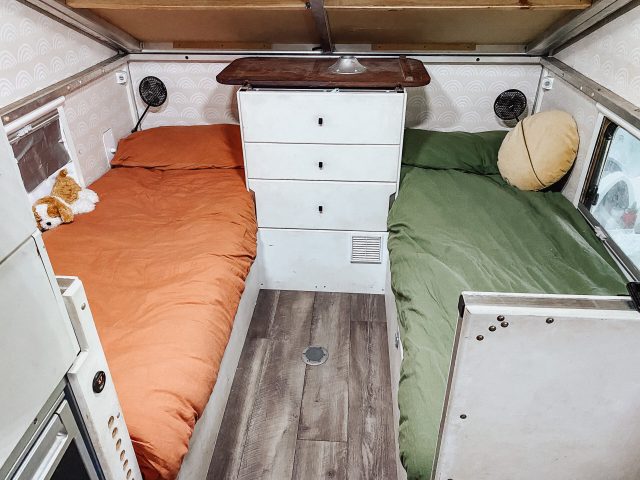
Is there anything you would have done differently going into the situation?
Yes, definitely. We did monitor the weather before entering, but we largely checked the forecast at the entry point near Birdsville. The conditions looked fine, but if we’d taken more time to assess the forecast from the other side of the desert, we would have noted more warning signs. I also wish we had our own satellite phone, but there were key reasons we didn’t. Firstly, this crossing would be the only time in our 14-month trip that it was necessary, and I happened to know you could rent them at the entry point in Birdsville and drop them off at Mount Dare when you exit. Initially, I planned to do this, but because our planned route bypassed Mount Dare and instead went to Unadata I didn’t. In hindsight, we should have rented one and gone straight to Mount Dare.
One of the big lessons was that when things started getting bad it would have been wise to just stop. I didn’t realize how quickly the mud flats dried out, but after spending five nights stuck out there, I watched the conditions improve. If something like that was to happen again, I’d park up and sit out the conditions for a few days.
Any final thoughts?
I still tell people to get out there and explore and [to not]let our experience deter you; we certainly won’t. You’ve got to plan and prepare accordingly, but you can’t be prepared for everything. We’re also actively encouraging and educating people about the personal locator beacons, it’s an essential item for overlanding, particularly in Australia, and if this article convinces one person to get one then that’s huge for us.
Our No Compromise Clause: We carefully screen all contributors to ensure they are independent and impartial. We never have and never will accept advertorial, and we do not allow advertising to influence our product or destination reviews.


